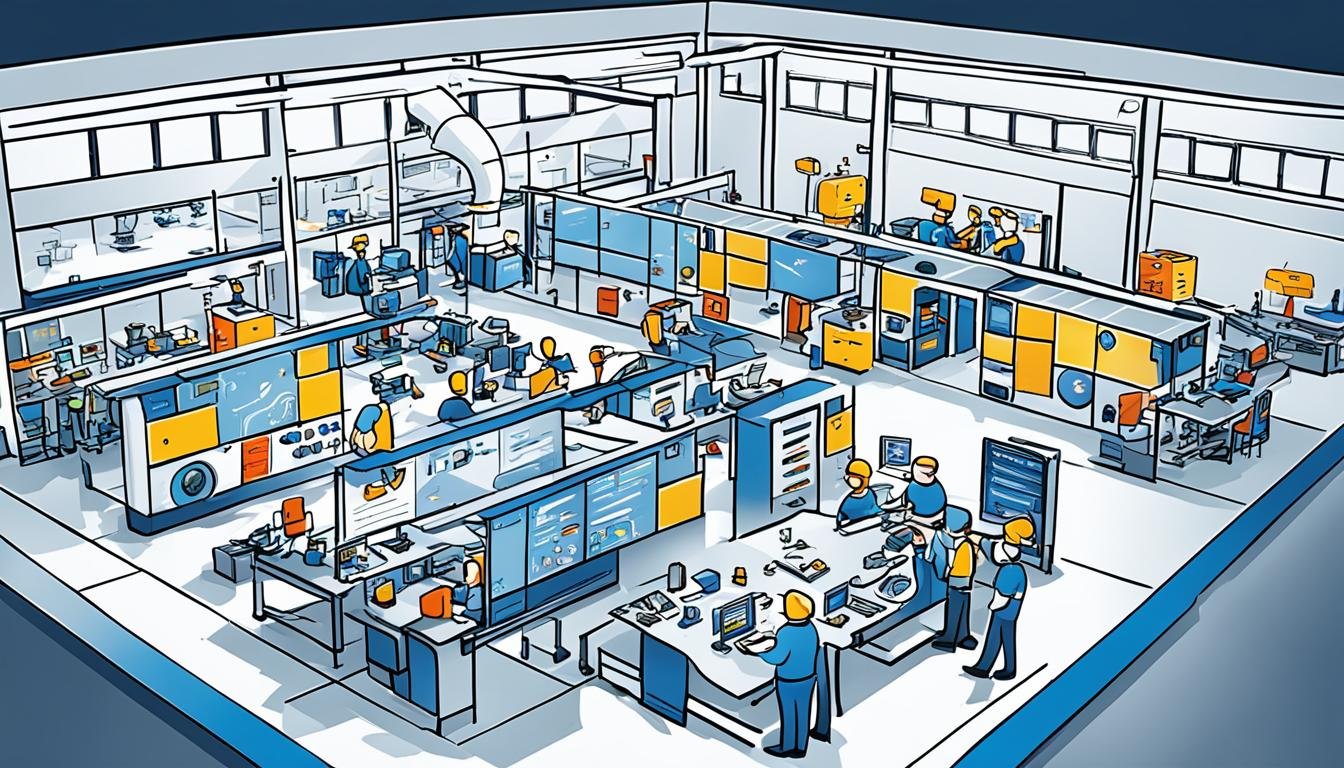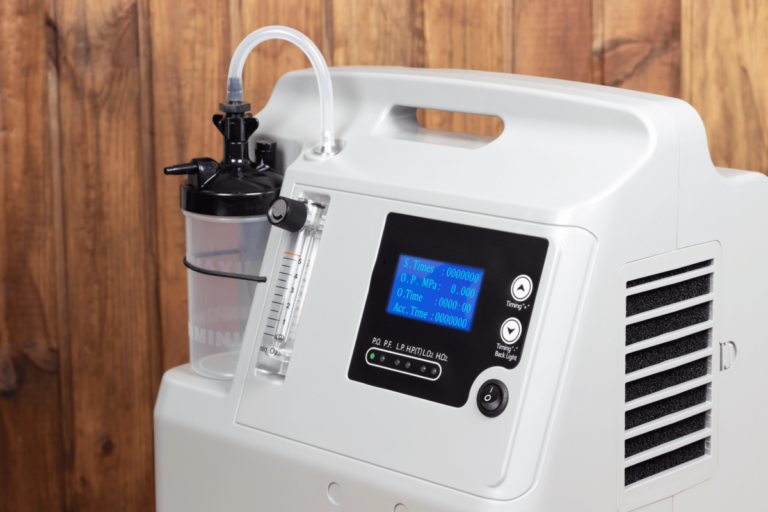Innovative Problem-Solving Strategies for Manufacturing
Did you know that about 10% of parts made in manufacturing have surface defects? This is way more than the 2% standard. This shows how important it is to solve problems well in manufacturing. Companies like Samsung, LG Electronics, and TSMC have found new ways to do this, making their work better and products better too.
Manufacturers deal with many problems, like changing demand, keeping quality up, and keeping machines running. To stay ahead, seeing problems as chances to get better is key. This idea comes from Lean principles, which says to face problems directly. Using strategies like Process Optimization, Value Stream Mapping, and Agile Methodologies can really make production better and keep it getting better.
Tools like PDCA cycles and Six Sigma help manufacturers find what adds value and get employees to solve problems. Using Value Stream Mapping and Agile Methodologies can make things run smoother, cutting down on mistakes and delays. For example, a 2020 study with TSMC showed that using TRIZ cut down on extra nitrogen ion doping by 20%. This shows how a planned approach to solving problems can pay off.
Companies like Boeing, Rolls Royce, General Electric, Hewlett-Packard, and Motorola know that solving problems in a planned way is key. They make better decisions and innovate by using these strategies. Their stories show how important it is to use these methods to make manufacturing better and tackle tough challenges.
Key Takeaways
- Surface defects in manufactured parts can be as high as 10%, well above the acceptable standard of 2%.
- Industry giants like Samsung, LG Electronics, and TSMC have successfully implemented innovative problem-solving strategies.
- Embracing Lean principles and viewing problems as opportunities is crucial for competitive manufacturing.
- Tools such as PDCA cycles and Six Sigma are essential for Process Optimization.
- Adopting Value Stream Mapping and Agile Methodologies can significantly improve production efficiency.
- Case studies, like TSMC’s TRIZ application, show substantial improvements in manufacturing processes.
- Leading companies value structured problem-solving methods for effective decision-making and innovation.
Understanding the Importance of Problem-Solving in Manufacturing
Effective problem-solving is key in manufacturing. It drives progress and ensures efficiency. By embracing Lean Manufacturing and Continuous Improvement, companies can tackle issues and build a lasting culture of excellence.
Lean Manufacturing Principles
Lean Manufacturing aims to cut waste and boost efficiency. It’s crucial to know what adds value and what doesn’t. Taiichi Ohno, the creator of the Toyota Production System, stressed finding the root of problems, not just their symptoms.
Using these Lean principles can greatly improve areas like Overall Equipment Effectiveness (OEE). By refining processes, manufacturers can ensure quality and efficiency.
Continuous Improvement
Continuous Improvement, or Kaizen, means always working to get better. It involves everyone at all levels, building a sense of ownership and teamwork. This teamwork boosts morale and improves problem-solving skills.
Methods like the 8-step problem-solving process offer a clear way to tackle issues. This method, based on the PDCA cycle, is widely used. Places like MANTEC in South Central Pennsylvania provide services to improve problem-solving, streamline processes, and adopt new tech.
| Overview | Details |
|---|---|
| Problem-Solving Approaches | 8-step method and PDCA cycle |
| Key Influencers | Taiichi Ohno, Toyota Production System |
| Supporting Agencies | MANTEC, Kepner-Tregoe |
| Core Skills | Root cause identification, team engagement, process improvement |
Combining Lean Manufacturing and Continuous Improvement leads to lasting solutions. It builds a culture of proactive problem-solving. This approach not only solves current issues but prepares companies for the future.
Key Steps in the Problem-Solving Process
Effective problem-solving in manufacturing follows a seven-step approach. It starts with identifying and analyzing the problem. Then, it moves to generating and implementing solutions, with ongoing evaluations.
Identify the Problem
The first step is to clearly identify the problem. Using the 5 Ws and H (Who, What, Where, When, Why, and How) helps understand the problem’s scope and nature. This sets the stage for a thorough problem-solving process.
Define the Problem
Defining the problem means understanding its impact on manufacturing. It’s important to gather data and facts about the problem’s severity and implications. Good communication and teamwork ensure all parts of the problem are clear.
Find the Root Cause
Finding the root cause is a key step in solving problems. Techniques like the Five Whys method help uncover the core issues. This ensures solutions tackle the problem at its source.
Brainstorm Solutions
Brainstorming and creative techniques like Kaizen and problem-solving games are used here. These activities bring together innovative solutions through teamwork. They encourage different ideas and perspectives.
Test and Implement Solutions
After brainstorming, solutions are tested with controlled experiments. Then, the chosen solution is implemented. This phase needs careful planning with clear roles, actions, and timelines for success.
Document and Standardize
Once a solution works well, it’s important to document and standardize it. Methods like DMAIC (Define, Measure, Analyze, Improve, Control) help keep the new standards in place. This prevents the problem from happening again and encourages ongoing improvement.
Using structured problem-solving and root cause analysis in manufacturing boosts efficiency. It leads to sustainable growth and ongoing innovation.
Five Useful Problem-Solving Strategies
Effective problem-solving in manufacturing needs logical analysis and structured approaches. Here are five strategies that help in addressing and solving manufacturing challenges.
8D (Eight Disciplines Problem Solving)
The 8D Problem Solving method is a detailed process. It uses a cross-functional team to deeply analyze the problem. Steps include setting up the team and taking long-term corrective actions.
Tools like the 5 Whys and Pareto analysis are used. They ensure root causes are fully checked.
PDCA (Plan-Do-Check-Act)
PDCA is a four-step method for managing and improving processes. It’s widely used in Lean Manufacturing. PDCA encourages ongoing improvements with data and feedback loops.
DMAIC (Define, Measure, Analyze, Improve, Control)
DMAIC comes from Six Sigma and focuses on data-driven strategies. It tackles complex problems with statistical tools and techniques. Design Thinking can be added to boost creativity in the Analyze and Improve stages.
QRQC (Quick Response Quality Control)
QRQC is great for solving immediate problems on the shop floor. It quickly identifies and contains the issue, then analyzes and fixes it. This method is key when keeping operations running smoothly is important.
Four A’s Method
The Four A’s method—Assess, Analyze, Act, and Achieve—offers a clear problem-solving sequence. It starts with a detailed assessment and moves to analysis. Then, teams act on insights to achieve lasting solutions. This method is great for a systematic approach to solving problems in manufacturing.
Innovative Problem-Solving Strategies for Manufacturing
New ways of thinking and systematic methods are changing how we solve problems in manufacturing. Companies like TSMC use TRIZ to tackle complex issues in making semiconductors. This approach brings new ideas and technologies to old processes.
At the Red Lake gold mine, over 1,400 experts from more than 50 countries worked together. They found rich drill sites and won $575,000. This shows how global teams can solve big problems together.
Creative problem-solving in manufacturing is key to adapting to change. Leaders can tackle unexpected challenges and solve tough problems. For example, a drug company boosted its returns by focusing on certain doctors.
The Evolutionary flexon framework quickly sorts out bad solutions by promoting diversity and randomness. The Decision-agent flexon method brings together people at different levels to find the best solutions for everyone.
Design Thinking helps with creative problem-solving by looking for open-ended solutions. It has four phases: Clarify, Ideate, Develop, and Implement. Tools like brainstorming and thinking of new worlds help make this approach work better.
Knowing the different types of innovation helps too. Sustaining innovation solves known problems with known skills. Breakthrough innovation tackles big, known problems. Disruptive innovation is for when the problem is big but the skills are there. Basic research is for exploring new areas with unknown problems and skills.
A tech firm showed how Problem-Solving Innovation can improve operations. They made a sensor to detect pollutants underwater at very small levels. This shows how new strategies can lead to big improvements in manufacturing.
Case Study: Applying TRIZ in the Semiconductor Industry
In the fast-paced semiconductor industry, solving complex problems is key. This case study shows how TRIZ helped TSMC overcome nitrogen doping issues. It highlights the power of a systematic approach to solving problems.
Identifying and Analyzing the Problem
TSMC was struggling with nitrogen doping in their chips. By deeply examining the system and tracing causes, they found the main issue. Defect Metrology Technicians played a big role by sorting out defects and pinpointing the equipment problems.
Applying Inventive Principles
TRIZ helped TSMC come up with new solutions. They used Altshuller’s Matrix and Inventive Principles to improve. This led to a big leap in how DefMet Technicians recorded data, making it more efficient.
Experimental Validation and Results
Experiments proved that TRIZ-based solutions worked well. TSMC tested and refined these solutions, showing their effectiveness. The results were a big win for quality and efficiency in manufacturing.
| Statistic | Details |
|---|---|
| IC Industry Trade Export (2017) | 2.4 trillion NTD |
| IC Industry Trade Import (2017) | 1.3 trillion NTD |
| Trade Surplus (2017) | 1.1 trillion NTD |
| Total Export Value (2017) | 8.4 trillion NTD |
| Total Import Value (2017) | 7.7 trillion NTD |
Using TRIZ and Lean, the semiconductor industry is setting new standards for solving problems. This approach is driving progress in the field.
Conclusion
Manufacturers need to focus on solving problems in new ways to tackle complex issues. It’s crucial to always improve and work together to fix problems. Lean Manufacturing and Agile Methodologies are key to making things more efficient and productive.
Many factories aim for a 2-3 percent better use of equipment each year. This shows how important small improvements can be. Using structured problem-solving methods, like the Toyota process, can lead to big improvements.
Data from past performances, along with AI and machine learning, helps in solving problems faster. For example, the semiconductor industry uses TRIZ for creative solutions. This shows how thinking differently can lead to big results.
By using these methods and technologies, manufacturers can build a strong way to solve problems. New strategies help companies stay strong and flexible in a changing world. This approach helps solve current problems and prepares teams for the future. The main goal is to keep improving and setting the stage for ongoing success.
Source Links
- 10 Effective Problem-Solving Methods for Manufacturers
- Effective Problem Solving in Complex Manufacturing and Design
- The 8-Step Problem-Solving Method | Manufacturing Improvements
- What is problem solving and why is it important | Consulting and Training Solutions | Kepner-Tregoe
- Why Problem Solving is Important in the Workplace
- 40 problem-solving techniques and processes | SessionLab
- Effective Problem-Solving Techniques in Business
- 17 Smart Problem-Solving Strategies: Master Complex Problems | Onethread
- 5 Essential Problem-Solving Strategies Every Business Leader Should Know
- Problem Solving Strategies for the Workplace [2024] • Asana
- Five routes to more innovative problem solving
- What Is Creative Problem-Solving & Why Is It Important?
- The 4 Types of Innovation and the Problems They Solve
- (PDF) Reformulating a Semiconductor Information Problem with TRIZ
- Improving Problem-Solving in Manufacturing
- Problem Solving Through Toyota Lean Management







